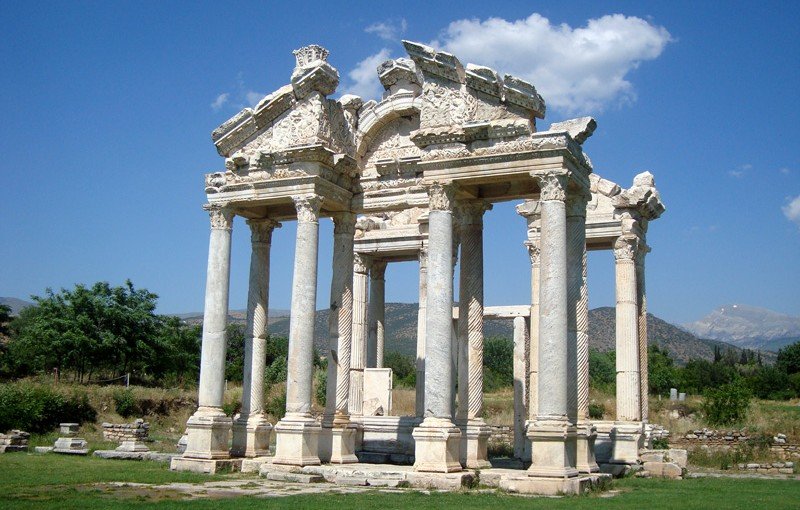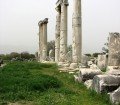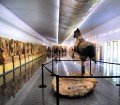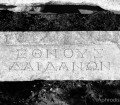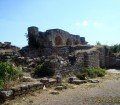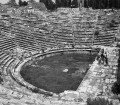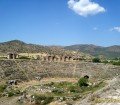Aphrodisias, once the capital of the province of Lydia, was located 38 km south of Nazilli and near the village of Geyre of region of the Karacasu. Like ancient times, as now, Aphrodisias attractive marble structure, the rich plants, almond, pomegranate and poplar trees in the middle of Dadaloz valley appeared. The city’s wealth became visible from cultural and political significance of the size and grandeur of the building. Aphrodisias’ name comes from Aprodite, the goddess of the beauty, love, nature and abundance, and it was one of the most famous temples. But this was not the real name. According to historian Stephanos it was found by Lelegianlar and it was known as Lelgonopolis first. Later, the name of the city was transformed into megalopolis and then again after Nino Assria king Ninos. The city’s history withstands to the Bronze Age and there is clear evidence related to the Chalcolithic culture from 3.000 years ago. Aphrodisias’ name began to be used in the Hellenistic period after 3000 in BC. Starting to spread the Christianity by Byzantine and adoption of Christianity as a religion gradually caused a major change in the status of the city. The worship center has reduced the importance of Aphrodite. Aphrodite and Aphrodisias finally were deleted from all paper. Efforts provided to be replaced to a Crusaders City, the name of Stauropolis. But the public chose to use Caria. Geyre, the name of the modern village, has occupied the same place. Probably, the old form of Caria turned after the Turkish invasion of the ancient Carian state. They were probably said Goyra to Caria, indeed it turned to ‘g’ and ‘a’ turned to ‘e’.
Aphrodisias was important city in his own like other Roman and Byzantine cities. Aphrodisias was surrounded with fertile soil grow all kinds of nutrients and was the first city of the era. In addition it had the sleek wall and cotton industries, advanced commercial, political, religious and cultural institutions, great art and painting tradition, philosophy and world-famous school of sculpture and large-bodied and energetic ring. The city’s weakening accelerated an unexpected incident in the 7th century. The Heraclius (610-641) kingdom was marked by Arab invasion from the east, religious conflicts, political and economic pressures and outbreaks of disease which caused great losses, but the last shot was an earthquake which devastated the whole place. Damages in buildings caused by the earthquake in Aphrodisias have been visible. Some pompous buildings were damaged and still not repaired. There is little known about the history of the city after the 7th century. The source of the information limited to the names of some bishops and religious documents. Archaeological findings show that small signs of life from the 11th century line with them. The raids of Seljuk to Anatolia were the last of the remaining settlement after major earthquakes. The whole region had to Aydin and Mentese principalities. Productive resources of the region in 15th and 16th centuries had caused new residential the Aphrodisias Geyre was occupied by peasants.
When you approach to the Aphrodisias from ruins, the City Defense Walls and City Plan Karasu, you can see the city’s walls with reinforcing pillars firstly. The old city was built on a region, leaning over the southwest. It is assumed that the construction of the wall was started because of the Gothic invasion in 260 years. However, the walls of the today were dated with 4th century of the AD or later from. There is no this kind of work, but it could be a wall between around agora and the theater. After the overthrow of the walls f the earthquake in the 7th century, an observation tower was built to the city’s highest place. This is one of the first two residential areas. One of the two excavations area which included the ruins of the prehistoric was built this hill, where the observation tower was built in the 7th century, other place occupied by the temple of Aphdodite. The Ancient Acropolis was settled on a hill and it gave an image from 24 meters in height. The shows indicate that there was a location, which related to prehistoric Bronze Age and Iron Age and was consisted of different layers. The walls were made of stone resembling Mudbrick megaton house walls and architectural structures found here. Also, it was known as pithoi and wheat and was quite small as well as large pottery jar that held the other provisions were also found. There were stone tools, owl statues of idols and images, fat women, and different weight measuring instrument. In the excavation area known as Molasses Mound at the east of the Acropolis, it had been found potteries and Klia statuettes of the end of the Neolithic and Chalcolithic era and in the beginning of the Bronze Age. The area surrounding the agora had improved a lot the end of the Hellenistic era. Nevertheless, there is no certain result whether it is really a city plan. Neither Aphrodite nor Sebastian fit a regular city plan.
